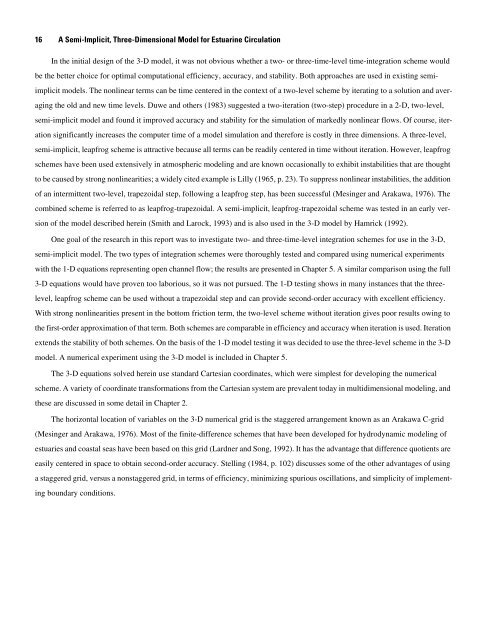A Semi-Implicit, Three-Dimensional Model for Estuarine ... - USGS
A Semi-Implicit, Three-Dimensional Model for Estuarine ... - USGS
A Semi-Implicit, Three-Dimensional Model for Estuarine ... - USGS
You also want an ePaper? Increase the reach of your titles
YUMPU automatically turns print PDFs into web optimized ePapers that Google loves.
16 A <strong>Semi</strong>-<strong>Implicit</strong>, <strong>Three</strong>-<strong>Dimensional</strong> <strong>Model</strong> <strong>for</strong> <strong>Estuarine</strong> Circulation<br />
In the initial design of the 3-D model, it was not obvious whether a two- or three-time-level time-integration scheme would<br />
be the better choice <strong>for</strong> optimal computational efficiency, accuracy, and stability. Both approaches are used in existing semi-<br />
implicit models. The nonlinear terms can be time centered in the context of a two-level scheme by iterating to a solution and aver-<br />
aging the old and new time levels. Duwe and others (1983) suggested a two-iteration (two-step) procedure in a 2-D, two-level,<br />
semi-implicit model and found it improved accuracy and stability <strong>for</strong> the simulation of markedly nonlinear flows. Of course, iter-<br />
ation significantly increases the computer time of a model simulation and there<strong>for</strong>e is costly in three dimensions. A three-level,<br />
semi-implicit, leapfrog scheme is attractive because all terms can be readily centered in time without iteration. However, leapfrog<br />
schemes have been used extensively in atmospheric modeling and are known occasionally to exhibit instabilities that are thought<br />
to be caused by strong nonlinearities; a widely cited example is Lilly (1965, p. 23). To suppress nonlinear instabilities, the addition<br />
of an intermittent two-level, trapezoidal step, following a leapfrog step, has been successful (Mesinger and Arakawa, 1976). The<br />
combined scheme is referred to as leapfrog-trapezoidal. A semi-implicit, leapfrog-trapezoidal scheme was tested in an early ver-<br />
sion of the model described herein (Smith and Larock, 1993) and is also used in the 3-D model by Hamrick (1992).<br />
One goal of the research in this report was to investigate two- and three-time-level integration schemes <strong>for</strong> use in the 3-D,<br />
semi-implicit model. The two types of integration schemes were thoroughly tested and compared using numerical experiments<br />
with the 1-D equations representing open channel flow; the results are presented in Chapter 5. A similar comparison using the full<br />
3-D equations would have proven too laborious, so it was not pursued. The 1-D testing shows in many instances that the three-<br />
level, leapfrog scheme can be used without a trapezoidal step and can provide second-order accuracy with excellent efficiency.<br />
With strong nonlinearities present in the bottom friction term, the two-level scheme without iteration gives poor results owing to<br />
the first-order approximation of that term. Both schemes are comparable in efficiency and accuracy when iteration is used. Iteration<br />
extends the stability of both schemes. On the basis of the 1-D model testing it was decided to use the three-level scheme in the 3-D<br />
model. A numerical experiment using the 3-D model is included in Chapter 5.<br />
The 3-D equations solved herein use standard Cartesian coordinates, which were simplest <strong>for</strong> developing the numerical<br />
scheme. A variety of coordinate trans<strong>for</strong>mations from the Cartesian system are prevalent today in multidimensional modeling, and<br />
these are discussed in some detail in Chapter 2.<br />
The horizontal location of variables on the 3-D numerical grid is the staggered arrangement known as an Arakawa C-grid<br />
(Mesinger and Arakawa, 1976). Most of the finite-difference schemes that have been developed <strong>for</strong> hydrodynamic modeling of<br />
estuaries and coastal seas have been based on this grid (Lardner and Song, 1992). It has the advantage that difference quotients are<br />
easily centered in space to obtain second-order accuracy. Stelling (1984, p. 102) discusses some of the other advantages of using<br />
a staggered grid, versus a nonstaggered grid, in terms of efficiency, minimizing spurious oscillations, and simplicity of implement-<br />
ing boundary conditions.

















